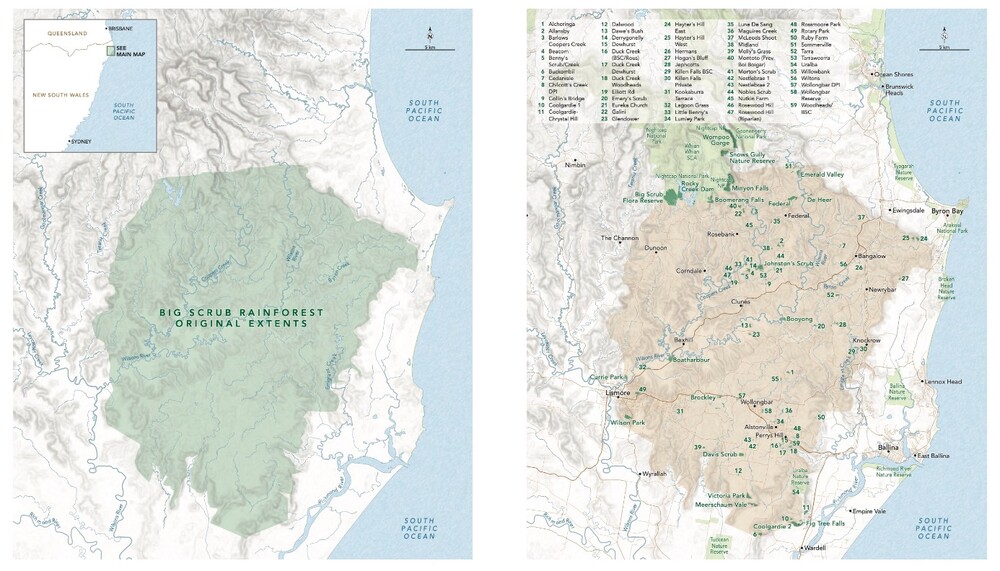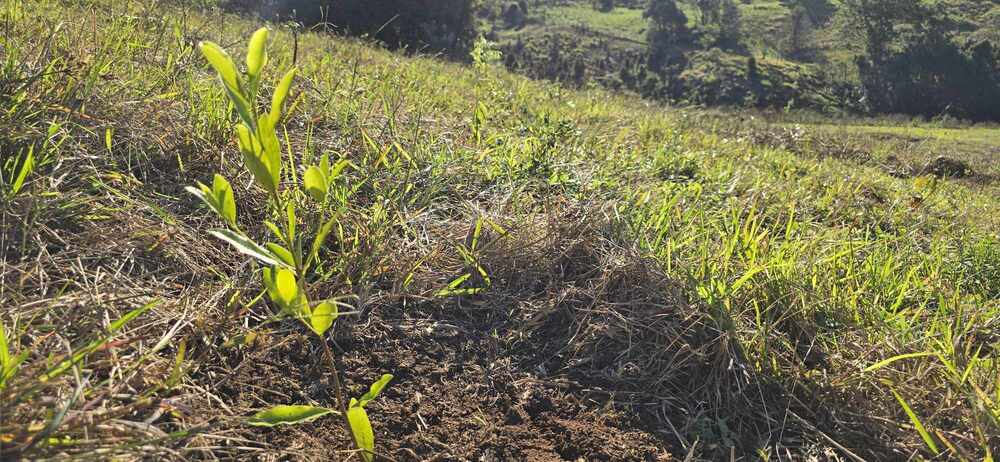Rewilding 27 hectares of Big Scrub area in Federal
Lara Leahy
04 June 2024, 10:30 PM
 Turning farmland into rainforest - Ready, set, grow!
Turning farmland into rainforest - Ready, set, grow!Greening Australia has its first commission in the Northern Rivers—to rewild 27 hectares of Big Scrub in the beautiful hills and dales of Federal.
Standing at the top of the property that is already feverishly undergoing vast change, the Program Specialist, Ian Rayner, talks about assisting with the rewilding of this farmland.
”There is less than 1% of the original big scrub left - around 750 hectares of remnants. By doing projects like this, we're adding to that, and it can really make a big difference to the total area we have. I think it's really great to be involved in it.”

“As far as we know, it's one of the biggest rainforest restoration sites in the Big Scrub area that's been done. Both by area and by number of trades. It's a big restoration effort that's going to produce a very biodiverse rainforest environment that will be a fantastic legacy at this property and for this area.”
A couple of black cockatoos call out as they fly overhead, almost in approval of the works.
This restoration is part of a much larger carbon credit plan for Nestle, which is planting 10 million plants all over Australia. Greening Australia matches people who want their land returned to a natural state, with those organisations and people who want to sequester carbon to offset emissions.

(Lush, hilly country)
Greening Australia is set up to accommodate big orders.
“This is a large-scale project, however some are larger. We are putting in a million or more trees into single sites.”
Ian speaks highly of the assistance his team have encountered coordinating the Big Scrub project.
“Greening Australia has been lucky to work with many local experts, who have been doing rainforest restoration for over 30 years. Firewheel Nursery, Bug Scrub Conservancy, there is a lot of experience and knowledge that were key in making this project what it is.
“On properties like this, there is some remnant vegetation, existing trees that show you what would have been here.

(Pockets of natural rainforest)
“We've also got excellent mapping of vegetation communities, so you can see at a fairly fine scale soils, topography, rainfall, all the factors that go into what can grow in an area. There are fairly good models of what might have been here pre-clearing.
“All that goes into informing the species that we are able to plant, and in this case, we're amazingly lucky that we've got access to 70 different species of rainforest trees and shrubs that we’re able to put back on this site. This is phenomenal diversity that we're able to restore.”

(Nursery plants pre-mixed for their topographical locations)
This kind of detail makes for a large difference in the success of the project. Ian expects a very large uptake of tree survival - about 80 to 90%, “There's a real range of aspects here. Next to quite a warm north-westerly facing slope, a few meters away, you will have a very cool wet southerly facing slope and different species will perform on those different aspects.”
All of these trees represent Australian Carbon Credit Units, or ACCU’s. ACCUs are tradable certificates representing one tonne of carbon dioxide equivalent emissions reduced or removed from the atmosphere.
The clean energy regulator reports that “In 2023, 17.2 million ACCUs were issued, slightly lower than the 17.7 million ACCUs issued in 2022. In Q4 2023, 4.0 million ACCUs were issued. We expect to issue at least 20 million ACCUs in 2024.”
Carbon Positive Australia says, “The amount of carbon sequestered per hectare depends on tree growth, which depends on the species and the planting density. In high rainfall zones with good quality soil, it may take 3-5 trees over 25 years to remove 1 tonne of carbon dioxide.”

(Ready, set, grow!)
Ian explains, “There is a 25-year minimum process for carbon sites like this. So that means there are at least 25 years that those trees are going to be looked after in some way to make sure they make sure they're happy and thriving by the end of that time.
“Those carbon credit units can be gained by the landholder or by our partners, or by Greening Australia. The carbon forms in a curve, so over a few years, you'll see the ACCU’s generating and then taper off at 25 years. And as they're generated, you can use them.”
The process is quite involved. “Before the plants are put in the ground, there's quite a lot of work that has to go into preparation, slashing, weeding and digging.
“After they're planted, we're looking at a three-year maintenance regime. It’s quite intensive. Each single plant gets its own TLC. At least four times a year over the first couple of years, and then into year three, it slows to three times.

(Planting preparation by buggy)
“At that stage, hopefully, they're getting to a size, and there's enough of that rainforest canopy coming in that you're getting basically canopy closure. That helps shade out grasses and other weeds from coming in, and then the maintenance drops off quite sharply.”
If you are interested in getting involved, Ian says, “We're always looking for people who are interested in working with us. The minimum planting area is around 15 to 20 hectares.
“We understand that it isn't always easy to give up, but for the sort of work that we're doing, that's the minimum we need.”
In the creation of a project, it is decided who gets the ACCU. With an active market in Australia for those credits that can be an income stream for a landholder. Have a look at Greening Australia or the Clean Energy Regulator for more information.

